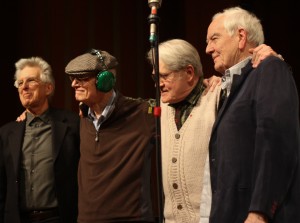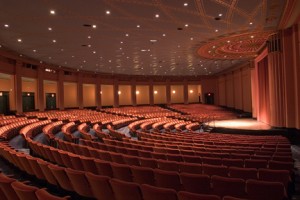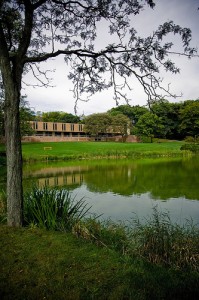
Last night, Rackham Auditorium on Washington Street in Ann Arbor, MI became a sort of communal time machine. Complete with a vintage magnetic tape reel, electronic synthesizer and “public disturbance”, performed by students from the University of Michigan School of Music’s Composition Department, the hall carried its occupants back to the revolutionary decade of the 1960s when a group of young, local composers called the ONCE Group started a groundbreaking and historic contemporary music festival. These composers were Roger Reynolds, Robert Ashley, Gordon Mumma, Donald Scavarda (pictured to the right) and the late George Cacioppo, and the music they created for the ONCE festivals was on display last night to reenact the sounds of the original events.
The concert kicked off ONCE. MORE., an interdisciplinary celebration of ONCE and its related cultural period in American history, by presenting over three hours of music by the founding composers. After remarks by the co-directors of the concert series, University of Michigan School of Music Professor of Composition Michael Daugherty and Professor of Performing Arts and Technology Mary Simoni, the music began with Roger Reynolds’ Mosaic (1962) for flute and piano. Notably vibrant in its use of instrumental colors, many of which were produced via extended techniques, Mosaic seemed too introverted to be a concert opener. Nevertheless, University of Michigan Professor of Flute Amy Porter and Professor of Piano Performance John Ellis succeeded to draw me in to a complex musical world wherein the limits of acoustic instrumental sound were well traversed. I was left with the impression that the flute and piano behaved as one sound producing body, yielding an aural landscape that both yearned for and hinted at electronic music.
Next on the program was Robert Ashley’s in memoriam…Crazy Horse (symphony) (1963), which hands an ensemble of 32 players a series of graphic scores and lets them interpret the symbols as they wish. Crazy Horse and its companion piece on the second part of the concert, in memoriam…Esteban Gomez (quartet) (1963) epitomize the experimental and avant-garde sentiments that spawned the original ONCE concerts. As you would expect, these two improvised pieces were very different, but I felt like Crazy Horse was delivered more successfully. Mark Kirschenmann’s Creative Arts Orchestra presented in memoriam…Crazy Horse cohesively, developing specific sound ideas (i.e. verbal/oral noise, sustained tones/harmonies, dense polyphony, etc.) and passing them among the different instrumental forces on stage. In contrast, the University of Michigan’s Digital Music Ensemble’s performance of in memoriam…Esteban Gomez was unfortunately static and I was chagrined by their heavy use of modern sound manipulation technologies. However, it speaks to the flexibility of graphic notation that a piece like in memoriam…Esteban Gomez can be realized so differently at separate points in history and still fulfill the composer’s intention.




 For four weeks beginning October 12, 2010 at noon, remixers can visit Indaba’s
For four weeks beginning October 12, 2010 at noon, remixers can visit Indaba’s  With Britten’s Michelangelo Sonnets and his opera Peter Grimes staring up at us, we began to discuss their texts. We then pondered the connection between the poems and some biographical background: Britten and Pears’ early collaboration, their trip to America, and eventual partnership. In my initial lesson notes, I’d pointed out that theirs was a relationship that was frowned upon in many corners, and would still be illegal for more than two decades after they returned to Great Britain. I asked: what resonances to Britten’s life can be found in the poetry of Michelangelo?
With Britten’s Michelangelo Sonnets and his opera Peter Grimes staring up at us, we began to discuss their texts. We then pondered the connection between the poems and some biographical background: Britten and Pears’ early collaboration, their trip to America, and eventual partnership. In my initial lesson notes, I’d pointed out that theirs was a relationship that was frowned upon in many corners, and would still be illegal for more than two decades after they returned to Great Britain. I asked: what resonances to Britten’s life can be found in the poetry of Michelangelo? Arvo Pärt: Symphony No. 4
Arvo Pärt: Symphony No. 4 Estonian composer Arvo Pärt turned 75 yesterday. His record label ECM Records is celebrating his three-quarters of a century with two new recordings.
Estonian composer Arvo Pärt turned 75 yesterday. His record label ECM Records is celebrating his three-quarters of a century with two new recordings. There was a time – somewhat long ago – when recitals by string players and pianists were the well-subscribed while others raised eyebrows. In the postmodern era, things have become somewhat more egalitarian, and one is likely to see all sorts of combinations gracing recital stages. Still, a duo of Metropolitan opera musicians – flutist Patricia Zuber and percussionist Greg Zuber – are making the case for a pairing that is still somewhat unusual to become a part of the chamber music mainstream.
There was a time – somewhat long ago – when recitals by string players and pianists were the well-subscribed while others raised eyebrows. In the postmodern era, things have become somewhat more egalitarian, and one is likely to see all sorts of combinations gracing recital stages. Still, a duo of Metropolitan opera musicians – flutist Patricia Zuber and percussionist Greg Zuber – are making the case for a pairing that is still somewhat unusual to become a part of the chamber music mainstream. The trick for those who are part of an unusual pairing is to find, commission, and, essentially, create a literature for themselves. The Zubers have done all three in preparing their program for a recital this Sunday at
The trick for those who are part of an unusual pairing is to find, commission, and, essentially, create a literature for themselves. The Zubers have done all three in preparing their program for a recital this Sunday at